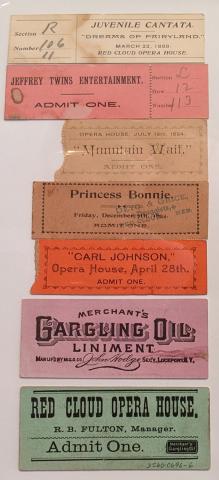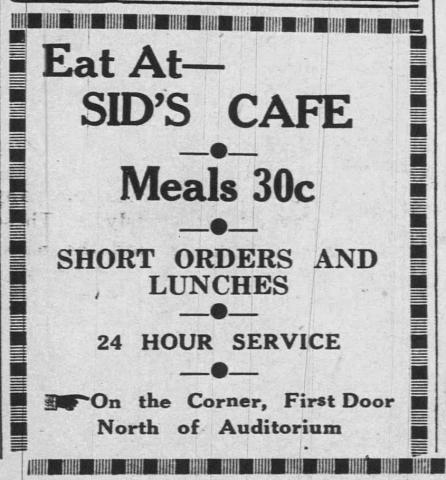

Annotations from the Archive: Webster County Collections
The installation of the Crossroads exhibit, from the Smithsonian’s Museum on Main Street program, was installed in the past few days. Large, nationally-touring exhibitions like this one always create a flurry of activity; from the time the first of the sixteen road cases is lifted off the truck until the last of the 255 individual exhibit pieces are put together, the installation team will have moved more than two tons of panels and displays. It’s a big job and an excellent exhibit that I’m sure our guests will enjoy.
Alongside the Crossroads exhibit though is a smaller local exhibition of materials pulled from the collections of the National Willa Cather Center and the Webster County Historical Museum. Our Changing Main Street highlights materials that were central to our understanding of early Red Cloud and Willa Cather’s adolescence here, as well as her use of prototypes and historical settings in her novels; many of the photos and memorabilia on display were collected early in our organizations’ histories and has seen less use in recent years. We believe it has great appeal, though, and we hope to use it to further document and preserve Red Cloud history, but we also need assistance from the community!
To that end, Teresa Young, Director of the Webster County Historical Museum, and Tracy Tucker, the archivist at the NWCC, developed the Main Street exhibit to depict the changes in Red Cloud’s business district in its first hundred years. Included in the exhibit are thirty-seven artifacts and 118 historic photos that are visually arresting and also invite comment and collaboration with local citizens, past and present. Images and artifacts from businesses that Willa Cather would have known include the Bon Ton Restaurant and Ludlow Cafe, Peoples’ Bank, State Bank, and Webster County Bank, The Palace Bakery and the Steiner Bakery, Platt & Frees Lumberyard, Cowden-Kaley Clothing, Slawson the ice man and several iterations of the street railway business and livery stables, just to name a few, with photos that date from 1873 to the 1950s. To study the images is to find yourself walking into Harry Gordon’s bank in Haverford, or renting a hack at a Sweet Water livery stable, or walking down the rutted dirt street of Hanover between the general store and the lumberyard.
In our Cather-focused world, we often think about Red Cloud as a sort of time capsule, largely unchanged from those days when Cather trod the board sidewalks of Webster Street as a teenager, but Cather was well aware of the evolution of local life; in letters to her Red Cloud acquaintances, she wrote about events like those depicted in the exhibit—business openings and losses, fire and scandal, the effects of economic and political policy on the town that she still called home. Expressing relief that a local mill was still in operation, Cather wrote in 1939, “Something goes on that is real, natural, logical—that boards and agents are having nothing to do with.” She kept a “crazy sort of scrapbook” of photos from both her travels and the sites from home.
We’d like to have our collections (at both the National Willa Cather Center and the Webster County Historical Museum) serve as Red Cloud’s “crazy sort of scrapbook.” The curators are anxious to talk with guests, both in-person and online, about their memories of Webster Street, to add materials and fill in collection gaps, and identify the people and places we can only guess about. For those who visit in person, the NWCC has provided a book to record any clues you have for us, and if you have items that you’d like to see preserved for the next hundred years of Red Cloud history, please contact NWCC archivist Tracy Tucker at ttucker@willacather.org. The Webster County Historical Museum will reopen for its season on April 1, 2022.
You can see selections from the exhibit in an online gallery HERE and for more about Crossroads: Change In Rural America click HERE. The exhibit will be in our Red Cloud Opera House Gallery through March 31.
